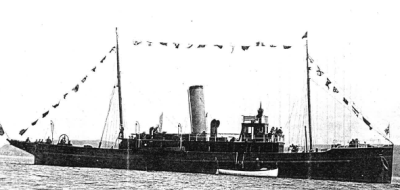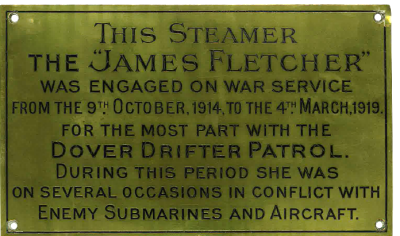Staff Serving During WW1
Following the outbreak of World War One many officers of Lancashire & Western Sea Fisheries Joint Committee answered the call to serve King and Empire. A record of those who served is still held within the reports of the committee’s meetings. To mark the centenary of the end of the war and to honour their service their names are published below:
Royal Naval Reserve
E.H. Nicholson
T.B. Richardson
R. Anderson
S. Porter
C.E. Wilson
R. Westhead
S. Croft
F.A. Jones
W. Dewhurst
C. Schofield
J. Leadbetter
G. Hanley
E. Gregg
British Army
C. Porter – Inniskilling Dragoons.
H. Baines – R.A.M.C.
W. Riddle – 8th Liverpool Irish.
T. Hampson – R.A.M.C.
Sadly, it was recorded in the report of 21st March 1917 that T. Hampson formerly a Scientific Assistant at Liverpool University had died following discharge from the Army.
Main Patrol Vessel’s Service During WW1
It was not only the staff of the committee that served in World War One. The main patrol vessel the “James Fletcher” was offered and accepted for service with the Royal Navy. The following excerpt from a report written by retired IFCO Steve Brown details the vessels service during the war.
In August 1914 when the clouds of war engulfed Europe the “James Fletcher” was offered and accepted for service with the Royal Navy, her crew sailed with her volunteering to serve to the man…
In war service “James Fletcher” and her crew served her country well. The Report for the Quarter Ending 31st December 1918 was no doubt written with tears of joy and pride if emotions were ever to be expressed in those less emotive times.
“The Committee’s steamer “James Fletcher” was returned to Wyre Dock, Fleetwood, while this report was on preparation. The Captain and all her crew were well after over 4½ years active service, and no casualties were recorded to any of her crew. There are shrapnel marks on the starboard door of the wheelhouse, and part of the foremast rigging was once shot away. The “James Fletcher” rammed and sank one submarine, which was afterwards found on the bottom by divers and she claims to have sunk another with depth charges.
During the whole of the 4½ years the “James Fletcher” was constantly engaged in the danger zone, and during that time she was never once late for service, and on many occasions took the place of other vessels which were temporarily unfit or unready for service. Her record shows that great credit is due to the captain and all the crew, who volunteered to go with her on active service in September 1914, and it gives me great pleasure to draw the attention of the Committee to these facts. Naturally after such a long period of active service the ship requires overhauling, and certain repairs are necessary. This inspection and repair work are being taken in hand forthwith, and at the same time preparations are being made for Lloyd’s No 3 survey, which is due this year. It is impossible at this stage to say what repairs are necessary and what their cost will be; a cursory inspection leads one to believe that the “James Fletcher” has not suffered any serious structural damage, though naturally a considerable amount of repair and renovation is necessary before she can be regarded as fit for sea again. The captain and all the crew are willing to re-engage in the Committee’s service.”
Cost of refurbishment after war service was reported as £3,050, the slightly lower amount of £3,010.9s.0d had been received from the Admiralty for her war service.
You can download the full report which details the history of the patrol vessels of the Sea Fisheries Committees of the north west by clicking the link below.

